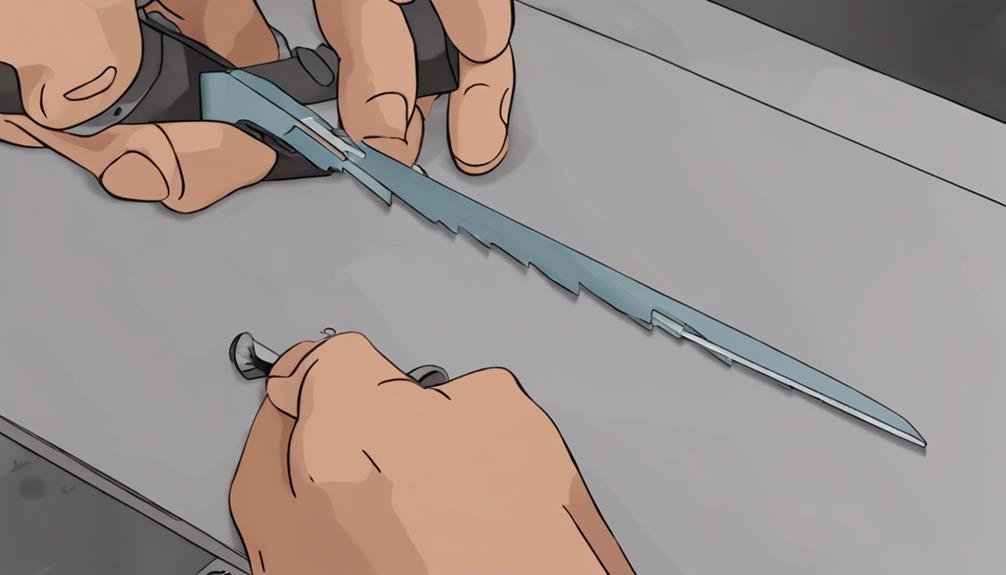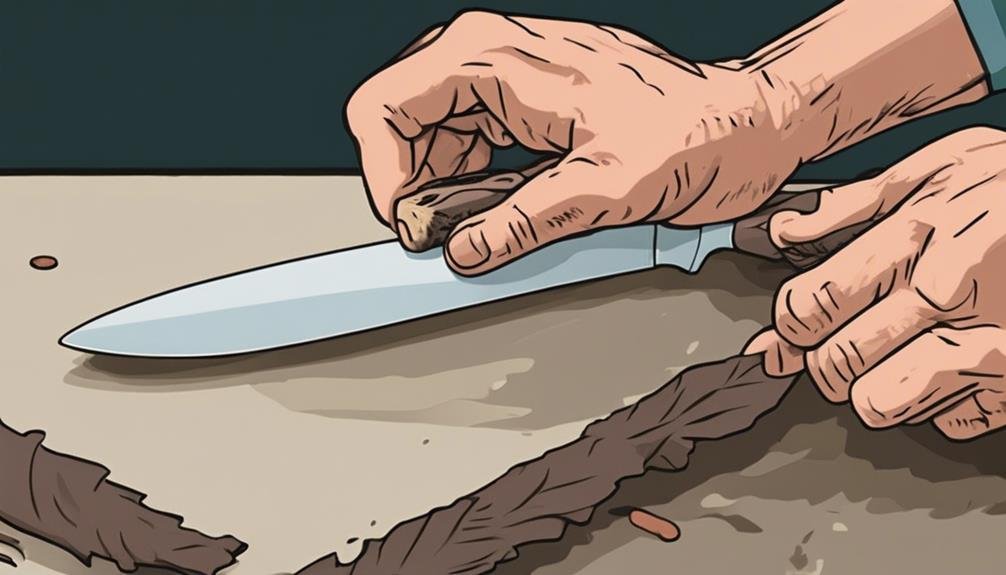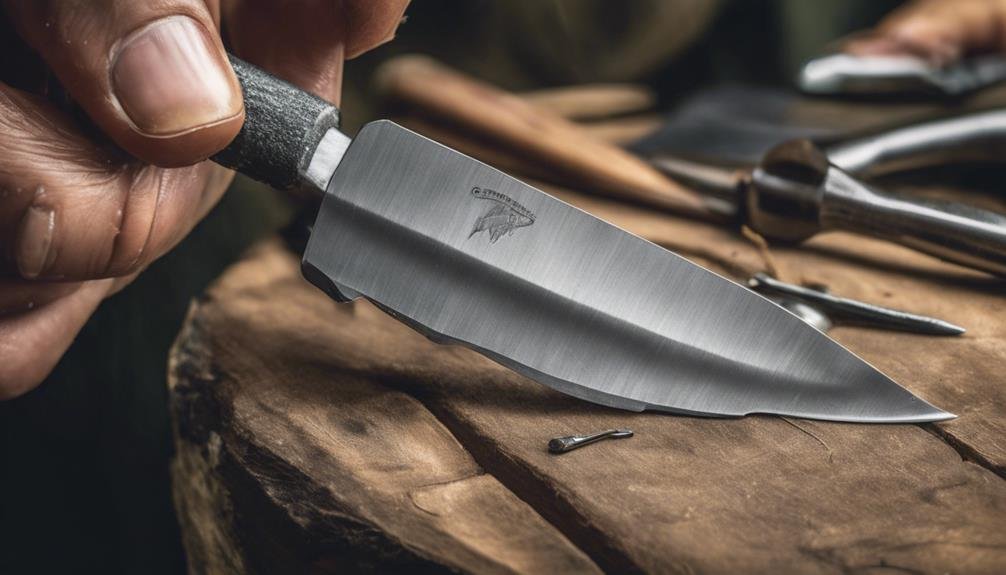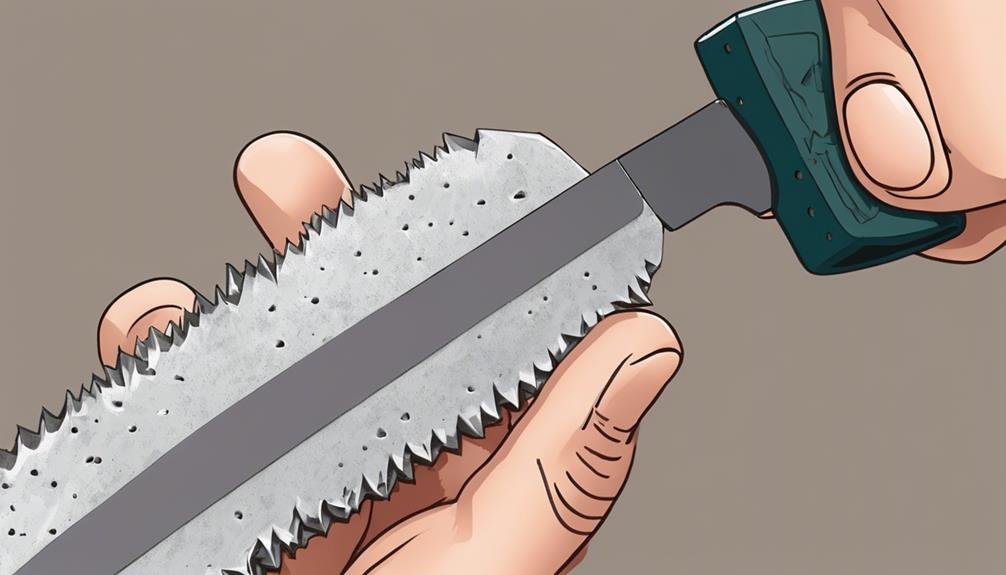Did you know that a survey revealed that over 70% of fishing enthusiasts struggle with keeping their serrated fishing knives sharp enough for best performance? Sharpening a serrated blade requires precision and the right technique to maintain its effectiveness. Understanding the intricacies of serrated blade design is important, but how can you make sure you are sharpening your fishing knife correctly to enhance your fishing experience?
Key Takeaways
- Use a small sharpening rod for precision in serrated blade maintenance.
- Lock the rod securely into a gullet and move smoothly in one direction.
- Apply light pressure to preserve serrations and avoid over-sharpening.
- Focus on maintaining gullets and teeth alignment for efficient cutting.
- Practice on inexpensive knives to hone sharpening skills before working on premium tools.
Understanding Serrated Blade Design
To comprehend the intricacies of serrated blade design, it’s vital to grasp how the scalloped edges function in cutting tough materials effectively. Serrated knives, with their unique scalloped edges, create small points of contact that reduce drag when cutting through challenging materials such as rope, fish skin, and bone. This reduction in drag allows for smoother cutting motions, making serrated knives ideal for tasks that require precision and control.
These serrated blades are commonly found on fillet knives, making them a popular choice among fishing enthusiasts. The design of serrated knives not only enables them to cut through tough materials with ease but also helps maintain sharpness longer than traditional straight-edged blades. This durability is a key factor in why serrated knives are favored in various cutting tasks.
Understanding the design of serrated knives is essential for selecting the appropriate sharpening techniques to keep them effective and efficient. By comprehending how the scalloped edges work in tandem with the blade’s overall design, you can make informed decisions on maintaining the sharpness and longevity of your serrated knives.
Importance of Specialized Sharpening Techniques
When sharpening your serrated fishing knife, precision in maintaining the sharpening angle is essential for ensuring peak cutting performance.
Additionally, using specialized sharpening tools designed for serrated blades will help preserve compatibility with the unique material of the knife.
Sharpening Angle Precision
For achieving peak cutting performance with serrated fishing knives, precision in maintaining the sharpening angle is paramount, necessitating the use of specialized sharpening techniques. Serrated knife sharpening demands attention to detail to guarantee the correct angle is upheld, preserving the knife’s cutting ability.
Specialized sharpening tools are essential to uphold the precise angles needed for these knives. Failing to maintain the original angle of the serrations can greatly impact the knife’s effectiveness in cutting through tough fishing materials.
Blade Material Compatibility
Why is blade material compatibility essential when considering specialized sharpening techniques for serrated fishing knives?
Serrated fishing knives often come in various blade materials, each requiring specific sharpening methods to maintain their sharpness effectively. Understanding the compatibility between the sharpening tools and the blade material is crucial to prevent damage and ensure optimal results. Utilizing improper sharpening techniques can’t only reduce the effectiveness of the serrated knife but also harm its blade material. By selecting the best sharpening techniques tailored to the specific blade material of the serrated fishing knife, you can prolong its lifespan and maintain peak performance.
Blade material varies in serrated fishing knives.
Specific sharpening methods are needed for different blade materials.
Compatibility between sharpening tools and blade material is crucial.
Improper techniques can damage the blade material.
Selecting the right technique enhances the knife’s performance.
Utilizing a Small Sharpening Rod

To effectively sharpen serrated fishing knives, employing a small sharpening rod is vital for maintaining the blade’s edge. When using a small sharpening rod, it is important to lock it into a gullet of the serrated blade. This guarantees that the rod properly fits the serrations and sharpens them effectively. To provide a clear understanding of this technique, let’s break down the process into a table:
| Serrated Knife Sharpening Technique with a Small Sharpening Rod | Instructions |
|---|---|
| Lock the rod into a gullet of the serrated blade | Ensure a secure fit for effective sharpening. |
| Work the rod in one direction | Maintain consistency for a sharp edge. |
| Use slow, smooth motions away from the knife | Prevent damage and maintain the serrations. |
| Avoid sharpening wider than the serration | Preserve the knife’s serrated edge. |
Mastering the art of using a small sharpening rod designed for serrated blades is essential for keeping your fishing knives sharp and ready for action.
Executing Slow and Smooth Motions
Executing slow and smooth motions when sharpening a serrated fishing knife is crucial for maintaining the integrity of the blade’s serrated edge. To guarantee you sharpen your serrated blade effectively, follow these steps:
- Controlled Movements: Move the sharpening rod with deliberate and controlled motions to preserve the serrated edge.
- Light Pressure: Apply gentle pressure while sharpening to avoid damaging the knife’s serrations.
- One-Directional Strokes: Make consistent strokes in one direction with the sharpening rod to prevent harm to the teeth of the serrated blade.
- Precision: Avoid sharpening wider than the serrations to maintain the intricate design of the serrated edge.
- Patience: Take your time and focus on each stroke to ensure a sharp and well-maintained serrated blade.
Applying Light Pressure Effectively

When sharpening a serrated fishing knife, applying gentle pressure is essential for maintaining the integrity of the serrations.
You should delicately guide the sharpening tool along the edge with minimal force to prevent any damage.
This technique guarantees that the serrated knife remains sharp and ready for your next fishing adventure.
Proper Angle for Sharpening
Maintain the effectiveness of your serrated fishing knife blade by sharpening it at an angle of around 20 degrees while applying gentle pressure. When sharpening serrated knives, remember the following:
- Precision is Key: Guarantee the blade is at the correct angle for best sharpness.
- Consistent Angle: Sustain a steady hand to keep the angle uniform along the blade.
- Light Touch: Apply just enough pressure to allow the sharpening tool to do its job without damaging the blade.
- Even Sharpening: Move the sharpener along the serrated edges evenly to avoid creating uneven cutting surfaces.
- Blade Longevity: Sharpening at the correct angle with light pressure preserves the knife’s durability for long-lasting performance.
Consistent Stroke Motion
To guarantee the effectiveness of your serrated fishing knife sharpening, focus on maintaining a consistent stroke motion while applying light pressure for best results. Consistency is crucial when sharpening serrated edges.
Make sure that each stroke covers the entire length of the blade to achieve uniform sharpness. By applying light pressure, you can control the sharpening process and prevent excessive removal of metal, prolonging the life of your knife.
Remember, uneven strokes can lead to inconsistent sharpening and potential damage to the blade, so keep your movements smooth and steady.
Practice this technique to achieve a sharp and durable edge on your serrated fishing knife, enhancing its cutting performance for your fishing adventures.
Use of Sharpening Stone
Applying light pressure effectively with a sharpening stone on a serrated fishing knife is key to preserving the delicate teeth and achieving a sharp edge. When dealing with a serrated edge, remember these tips for best sharpening:
- Light pressure is essential to prevent damage to the serrations.
- Maintaining the integrity of the serrated edge is easier with gentle pressure.
- Proper technique on a sharpening stone can retain the unique cutting abilities of a serrated fishing knife.
- Careful application of pressure guarantees a gentle yet effective sharpening process for serrated blades.
- Using light pressure is vital for preserving the precision and functionality of your serrated fishing knife.
Focusing on Gullets and Teeth

To effectively sharpen a serrated fishing knife, pay close attention to the alignment and sharpness of both the gullets (valleys) and the teeth of the blade. The gullets, which are the recessed parts between the teeth, play a vital role in cutting performance. When sharpening, focus on maintaining the depth and shape of these gullets to guarantee smooth cutting. The teeth of the blade should also be sharp and aligned properly to enhance cutting efficiency.
Specialized sharpening tools with small rods that fit into the serrations are essential for this task. These tools allow you to work on each gullet and tooth meticulously. When sharpening, use slow and smooth motions away from the knife to prevent damage to the blade.
Avoiding Sharpening Beyond Serration Width
When sharpening a serrated fishing knife, it’s essential to avoid sharpening beyond the width of the serration to preserve its original shape and cutting effectiveness. Sharpening wider than the serration can alter the knife’s cutting ability and potentially damage the blade. Here’s why focusing on sharpening within the serration width is a good choice:
- Preserves Knife Shape: Sticking to the serration width maintains the knife’s original shape for peak performance.
- Guarantees Precision: Sharpening within the serration width guarantees precise sharpening for effective cutting.
- Maintains Cutting Performance: By not over-sharpening beyond the serration width, the knife retains its intended cutting performance.
- Prevents Uneven Cutting: Over-sharpening can lead to uneven cutting, affecting efficiency during fishing tasks.
- Enhances Effectiveness: Following the width of the serration preserves the knife’s effectiveness for intricate fishing activities.
Choosing to sharpen within the serration width is a good choice to maintain your serrated fishing knife’s cutting efficiency and longevity.
Practice on Less Expensive Knives

To enhance your sharpening skills effectively, start by practicing on less expensive serrated knives, gradually refining your technique for better results.
Using inexpensive knives allows you to experiment without the risk of damaging high-quality tools. This practice is important as it helps you develop a steady hand and a deeper understanding of serrated knife sharpening angles.
Mastering sharpening on cheaper knives can greatly improve your ability to sharpen premium serrated fishing knives efficiently.
Mastering Serrated Blade Sharpening Skills
To master serrated blade sharpening skills effectively, make sure you use a small sharpening rod that fits snugly into the serrations of the knife. Lock the rod securely into a gullet and move it in slow, smooth motions away from the knife. Apply light pressure and work the rod in one direction to avoid damaging the serrations.
Avoid sharpening wider than the serration to maintain the knife’s original geometry. A good job involves practicing on less expensive knives first to develop the skill needed for sharpening serrated blades effectively. Remember, consistency and precision are key when sharpening serrated blades.
Which Serrated Fishing Knife Sharpening Techniques are Best for Filleting Fish?
When it comes to sharpening your serrated fishing knife for filleting fish, it’s important to use the best techniques. First, make sure to use a honing rod specifically designed for serrated blades. Additionally, consider using a diamond-coated sharpening tool for the top filleting fish blade material to ensure a precise edge.
Frequently Asked Questions
How Do You Sharpen a Serrated Fish Fillet Knife?
When sharpening a serrated fish fillet knife, focus on the gullet and teeth for best results. Lock the sharpening rod into the gullet and use slow, smooth motions away from the knife. Apply light pressure to avoid damaging the serrations. Specialized tools like small tapered rods are essential.
Maintain the sharpening angles to keep your knife sharp and ready for precise filleting.
How Do I Sharpen My Serrated Knife?
To sharpen your serrated knife effectively, focus on the sharpening angles. Use a small sharpening rod to lock into the gullet of the knife for precision. Work the rod with slow, smooth motions, applying light pressure. Avoid sharpening wider than the serration to maintain the knife’s geometry.
Practice on less expensive knives to hone your skills. Concentrate on both the gullet and teeth for best sharpness restoration.
Can You Sharpen a Serrated Knife With a Pull Through Sharpener?
You can sharpen a serrated knife with a pull-through sharpener, but it’s generally not recommended for serrated knives. These knives have unique edges that require specialized tools for effective sharpening.
Pull-through sharpeners may struggle to reach the valleys of the serrated blade, potentially causing damage. To preserve the integrity of your serrated knives, it’s essential to choose the right sharpening technique and tools designed specifically for them.
Maximizing Sharpness: High-Carbon Steel Blades for Fishing Knives
Are Serrated Knives Harder to Sharpen?
Sharpening serrated knives can be more challenging compared to straight knives due to their unique blade design with small, scalloped edges. The valleys and teeth of serrated knives require specialized techniques for sharpening. Traditional methods mightn’t work well, so it’s crucial to use the right tools.
While serrated knives degrade slower, regular sharpening is important for best performance. Specialized sharpeners like the ChefsChoice Trizor XV focus on gullets and teeth for effective sharpening.
Conclusion
Now that you’ve honed your serrated fishing knife sharpening skills, you’re ready to slice through any challenge with precision and ease.
Just like a master angler effortlessly reels in the big catch, you’ll effortlessly maintain a sharp blade that’s as reliable as the rising sun.
Remember, practice makes perfect, so keep sharpening those skills and watch your fishing adventures become even more successful.
Happy sharpening!

